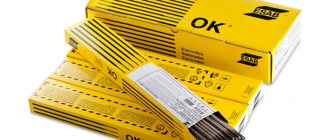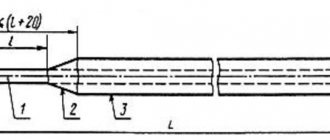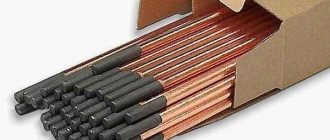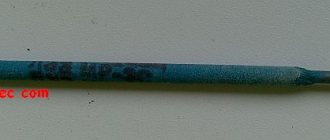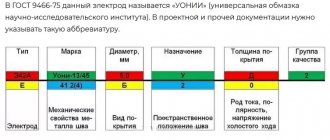Purpose and GOST
Products are produced for connecting steel parts:
- installation of pipes and gas pipelines in the absence of pressure;
- assembling structures using fillet welds.
ANO-21 is used in shipbuilding, housing and communal services, repair shops, dachas and private homes. Rods with a diameter of 2.5 and 3 mm are often used.
Products are manufactured in compliance with GOST 9467-75 and coated on the outside with a rutile coating. It stabilizes the arc, reduces the rate of spattering of hot metal, prevents the occurrence of oxidation processes, and protects the seam from oxygen penetration.
At the junction of the parts, a smooth roller is formed that does not contain pores. Approximately 1.5 kg of rods are consumed per hour. This is a high figure.
ANO-21 welding electrodes are used when connecting steel products and parts made of other metals. The rods are easily excited and maintain an arc, are powered by a 220 V electrical network, and form an easily removable slag coating. This corresponds to GOST 380-2005 or 1050-88.
Welding is carried out with direct and reverse current. ANO-21 guarantee the quality of work.
Electrodes ANO-4
Arsenal welding electrodes of the ANO-4 brand are used for welding work using the manual arc welding method. Can be used by professional craftsmen and beginners. They are most suitable for welding carbon steels. Welding electrodes Arsenal brand ANO-4 have different diameters - from 2.0 to 6.0 millimeters, which allows you to weld products from 3 to 20 millimeters.
Their main advantage is the rutile coating. It ensures rapid ignition of the arc and its further stable combustion. This makes the job easier and results in a high-quality seam.
The possibility of being in space depends on the size of the diameter of the consumable. Electrodes having a diameter of less than four millimeters can provide the ability to weld in a variety of existing positions. If electrodes whose diameter exceeds this value are used, then the limitation is the direction of movement of this consumable element during vertical welding - it should be carried out from the bottom position to the top, and not vice versa.
When welding, alternating current is used. To use a permanent one, you will have to use a transformer. No preliminary preparation is required. The undemanding nature of the surfaces being welded allows for rust residues and minor contamination.
When using ANO-4, the seam is of high quality and durable. There are practically no defects such as cracks and pores. Welding of critical structures is acceptable. Before starting welding, it is recommended to calcinate the electrodes for at least one hour, especially if they were stored in a damp room.
Explanation of markings
The symbols that are part of the full name of the product - E46-ANO-21-d-UD E 430/3/- R 11, have the following meanings:
- E46 – product type;
- ANO – brand;
- D – diameter;
- U – intended for carbon steels;
- D – thick protective coating;
- 43 – level of seam rupture;
- 0 – elongation 18%;
- 3 – viscosity;
- R – rutile coating;
- 1 – welding position – any;
- 1 – alternating current.
The rods were developed by scientists from the Electric Welding Institute.
Letter designations:
- A – Academy;
- N – Sciences;
- O – coated;
- 21 – model.
The data will help beginners choose electrode products.
An example of decoding electrode symbols.
Welding characteristics
Features of electrodes:
- product diameter – 1-5 mm;
- coating – rutile;
- metal spattering – does not exceed 4%;
- hourly consumption – 1.65 kg.
The arc remains smooth throughout the welding process.
The seam material can withstand:
- tensile strength – not less than 460 MPa;
- elongation – 18%;
- viscosity – 80 J/cm²;
- connection bend angle – 150°.
We recommend reading Features and main advantages of using E46 electrodes
Other parameters are also important.
Chemical composition of the seam
Even for a person without work experience, the connection point between the parts is strong. Molten and solidified metal contains the elements presented in the table.
| Name | Quantity in % |
| Carbon (C) | 0,1 |
| Silicon (Si) | 0,3 |
| Magnesium (Mn) | 0,5-0,8 |
| Sulfur (S) | 0,04 |
| Phosphorus (P) | 0,045 |
The above list complies with state standards and must be observed in the production of electrodes at all factories. In practice, the composition of the seam is slightly different when welding with rods from different manufacturers.
Smooth weld seam.
Physical properties
Rutile coating consists of titanium dioxide and other substances: silica, calcium carbonate, ferromanganese. The mixture allows you to cook wet and corroded parts. You can make connections at non-rotating joints, which are often found on pipelines.
Products with a diameter of 2, 3, 4 and 2.5 mm are easy to ignite and burn evenly, the molten material hardly splashes.
The Sv-08 wire (the electrodes are made from) contains additives that can increase the surface tension in the weld pool. This allows vertical and ceiling seams to be made without leaking metal.
The maximum permissible moisture content in the coating is 0.9%. For larger values, the rods are calcined for 30-40 minutes. The temperature is 120°C. In the future, electrodes are used for welding non-ferrous and ferrous metals, incl. and aluminum.
When purchasing, you should choose dry products. You shouldn’t settle for cheap products; it’s better to buy more expensive products from popular manufacturers.
When welding with an ANO-21 electrode, there is almost no spatter.
Welding modes
These indicators depend on the thickness of the electrode. The parameters are indicated in the table indicating the spatial location of the seam.
| Diameter (mm) | Length(cm) | Quantity (1 kg) | Current (A) | ||
| Lower | Vertical | Ceiling | |||
| 2 | 30 | 95 | 60-100 | 70-80 | 80-100 |
| 2,5 | 30 | 58 | 70-120 | 70-100 | 90-110 |
| 3 | 35 | 40 | 100-150 | 90-110 | 110-140 |
| 4 | – | – | 160-190 | 150-170 | 150-180 |
| 5 | – | – | 170-220 | 150-190 | 120-160 |
It is not recommended to weld workpieces thicker than 5 mm and pipe joints with subsequent injection of pressure.
Electrodes MP-3
In terms of their advantages, MRZ and ARS electrodes are similar to ANO-4 brand electrodes, but there are still some differences that make them even more popular. The welding workflow with this type of electrode is much easier than when using other models. Arsenal MP-3 electrodes can be used in industrial production and for domestic use.
One of the main features is that there is no need to remove slag residues from the surface of the seam, since it separates on its own. All that remains is to remove him from the place of work.
Another undeniable advantage is the ability to use MP-3 Arsenal electrodes for surfacing metal with gaps of a sufficiently large size. Their use allows welding not only on a short arc, which is still difficult, especially for beginners in this matter, but also on a long one.
The rutile coating, which includes titanium dioxide, provides strength and resistance to the formation of defects such as pores and cracks, and also reduces the susceptibility to corrosion. The coating has a slightly greenish color.
Arsenal 3mm electrodes allow you to work with a long arc, which is important when the surface is of poor quality and there are oxides on it. Arsenal 3 mm electrodes allow you to fill cracks and gaps of any size. The resulting seam is of high quality and even. The average consumption of electrodes for one hour of welding work is 1.7 kilograms, that is, in order to weld one kilogram of metal, 1.7 kilograms of MP-3 welding electrodes will be required.
The diameters are as follows: 2.5; 3.0; 3.2; 4.0; 5.0 millimeters. Such a large selection simplifies the welding conditions. Depending on the diameter of the electrode, the current value is set. If you have to work with structures that have walls of medium and large thickness, then the mode is set to the maximum, and the electrode is moved along the welding process with a slight inclination. You can weld using the short tack method.
If thick-walled parts are welded, then a reinforced seam is applied and the current size is increased. Electrodes with a diameter of 5.0 millimeters are used for work in the lower and vertical positions. Ease of use allows you to perform various types of welding work.
Dimensions and packaging
After release, the finished products are placed in moisture-proof film and a cardboard box. Packages of 1 or 5 kg are available for sale.
| Rod Diameter (mm) | Length(cm) | Weight 1 pc. (G) | Quantity per 1 kg |
| 1,6 | 25 | – | – |
| 2,0 | 25 | – | – |
| 2,5 | 30 | 17,0 | 58-59 |
| 3,0 | 30 or 35 | 26,5 | 38 |
| 4,0 | 45 | 53,0 | 18-19 |
| 5,0 | 45 | 84,5 | 12 |
| 6,0 | 45 | 135,0 | 7 |
We recommend reading Standard weight of electrode packaging
Small packages are convenient for home use.
Consumption rate
When connecting parts in small volumes, a competent calculation of the required number of electrodes and the diameter of the rod will ensure the continuous activity of the master and eliminate unjustified monetary costs.
This requires parameters that are inserted into tables developed by scientists from the Montazhspetsstroy Research Institute and other organizations. Detailed information about the types of welding is presented in document VSN 452-84.
In practice, the consumption is 1.65 kg for every hour of operation.
Pros and cons of using
Positive aspects of the rods:
- accessibility for all users;
- fast ignition and stable arc burning;
- hot metal hardly splashes;
- formation of an easily removable slag layer;
- seam strength;
- lack of sensitivity to galvanic protection and traces of rust on the edges of the metal being welded;
- reduced toxicity.
Negative features:
- welds only metals up to 5 mm thick;
- the use of fluxes is required;
- impossibility of welding high pressure pipelines.
Prices cover all existing shortcomings. You can purchase materials of different diameters in specialized stores by paying 70-152 rubles per 1 kg.
A pack of electrodes weighing 5 kg.
Advantages and disadvantages
Like any consumable material, ANO-21 welding electrodes have advantages and disadvantages. Let's start with the advantages:
- Available in the market and very popular;
- Low cost;
- Regardless of operating conditions, easy ignition of the arc is ensured;
- A light layer of slag is formed, which subsequently separates from the deposit without any problems during the control procedure;
- A sealed seam is created.
These advantages distinguish these electrodes from the line of consumables . But we should not forget about the disadvantages, including:
- Narrow scope of application;
- The coating is not reliable enough. Because of this, it is necessary to use additional fluxes and preparation of workpieces;
- The seams may not be strong enough, which is why they cannot withstand serious pressure and loads;
- Working with workpieces of significant thickness is unprofitable, since the result is a poor-quality seam.
We figured out the advantages and disadvantages of this consumable. But most of the disadvantages can be avoided if you use electrodes in a specific area and do not try for structures of significant thickness. And additional parts are relatively inexpensive and can be supplied to ensure the strength of the electrodes.
Features of operation and storage
The main property of rods coated with rutile coating is that they work in conditions of high humidity of the parts being welded and with metals with traces of rust on the edges being joined.
The electrode must remain dry. Therefore, it is better to store it in a hermetically sealed box in a warm room, away from the ground, away from sunlight. If it gets wet, it is dried for 40-60 minutes at a temperature of +90 ... +120 ° C.
Vertical fillet welds are made by holding the electrode at an angle of 40-70°. Do not exceed the recommended currents, this will lead to metal burns. The seam always turns out strong even by welders without experience. Waste is easily removed from metal.
Rods should be purchased from specialized stores that comply with the rules for storing welding consumables. The temperature in the warehouse must be at least +15°C.
Comparison table
Electrode products, including ANO-21, are produced by several enterprises. The manufacturing technology is not followed at all, for this reason the properties of products from different manufacturers differ in ignition, maintaining arc stability and the appearance of pores.
We recommend reading: How to use TsL-11 electrodes
Masters conducted comparison tests with the participation of ANO-21, MR-3 and SSSI. The test results depending on the welding direction are shown in the table.
| Index | ANO-21 | MR-3 | SSSI |
| Metal consumption (1 kg) | 1,7 | 1,7 | 1,6 |
| Viscosity (J/cm²) | 80 | 80 | 200 |
| Elongation (%) | 18 | 18 | 26 |
| Capacity (kg/h) | 1,4 | 1,7 | 1,3 |
| Yield Strength (MPa) | 460 | 400 | 350 |
| Maximum current (A) | 220 | 260 | 200 |
| Minimum current (A) | 40 | 30 | 40 |
| Calcination (min.) | 60 | 60 | 60 |
The table will help in selecting the electrodes needed for the job.
Distinctive features of some brands
ANO – 3
The brand performs welding of non-critical joints. Rutile coating creates easier conditions for welding work. Installation of tacks, even if there are many of them, is performed with these electrodes without any problems. No cleaning of oxides, oils or other dirt is required. The slag crust is easily removed, right up to self-separation.
ANO – 4
The high welding characteristics of these electrodes at a relatively low price make them in demand by welders, from amateurs to professionals. They can be used when welding both ordinary and critical joints.
Even when welding wet, rusty and oily surfaces, the coating protection prevents the formation of pores and cracks in the weld. The quality of the seam is not hampered by the use of increased welding current values.
ANO – 4I
This brand is distinguished by its ilmenite-based coating. Allows you to combine the properties of both acidic and rutile coatings. Improved sanitary and hygienic parameters in comparison with purely acidic powder is the main advantage of this brand. Rutile powder allows you to work on all types of currents, regardless of polarity. As a consumable material, it is used for welding metals with a tensile strength of no more than 46 kgf/mm2.
ANO – 6; ANO – 6M
The coating of these electrodes can be rutile or rutile acid. Some manufacturers include the mineral ilmenite in the powder to reduce harmful emissions.
They are distinguished by the ability to obtain a high-quality seam when operating in modes with increased current strength. ANO-6M allow less spattering and create conditions for easier disposal of slag crust than ANO-6 electrodes.
ANO – 8
The characteristics of this brand are in many ways similar to the ANO-27 electrode. The difference lies in the mechanical characteristics of the metals being welded. ANO -8 is used for welding low-alloy and carbon steels with a tensile strength of up to 46 kgf/mm2, and the same indicator for ANO -27 is higher - up to 50 kgf/mm2.
ANO – 9
This type has a base coating, so it can be used to obtain plastic and high-impact joints. Before welding, cleaning of the edges of the weld is required . All types of currents can be involved in the work, only constant ones must be with reverse polarity.
ANO – 12
The grade, coated with rutile powder, is used in working conditions during installation work, where it is not possible to thoroughly clean the welded edges and it is necessary to carry out the process in different spatial positions . The porosity of the seams is not affected by the use of increased current to ensure high-quality penetration.
ANO – 13
The grade with rutile cellulose powder is distinguished by high-quality welding in any location of the seam in space. What especially distinguishes it from other brands of electrodes is the ability to apply sutures in a vertical plane from top to bottom. In this position, he can weld overlapped, butt and corner seams.
ANO – 17
The acid-rutile coating of the electrode with the addition of iron powder determines the specifics of its application. This composition increases the deposition coefficient, which increases the productivity of working with such electrodes.
Increased fluidity makes welding in the lower position of thick-walled workpieces with a long seam length most popular. Increased energy costs are required, so it is better to use this brand in a production environment.
ANO – 21
For small-sized structural elements, these electrodes have a high degree of applicability. It is not recommended to use them when welding thick-walled workpieces , since there are no guarantees about the quality of the seam.
They are available on the domestic market and outperform their competitors in price. Welding wire, due to additives that increase surface tension, makes it possible to weld joints in all positions.
The characteristics are characterized by free arc ignition (initial and repeated), easy slag separation, stable arc combustion.
ANO – 24
The use of the mineral ilmenite (Fe – TiO2) in the coating of this brand makes it possible to reduce the amount of harmful substances during welding. Widely used in many areas of industry and construction, both conventional and connections with increased requirements. Almost any welding machine can operate on any current with any polarity. Works on contaminated surfaces using various technologies depending on the length of the arc (it can be different).
ANO -27
The base coating provides a protective environment that is virtually free of hydrogen. The absence or minimally permissible presence of this gas allows us to obtain plastic seams with high impact strength . The electrode makes it possible to maintain the strength properties of the seam at low temperatures (down to -40°C). About this brand here.
ANO – 34
Rutile coating makes it possible to weld workpieces with the presence of oxides on the surface of the edges.
Important : the idle speed of the welding unit should be 50 V. At a higher value, the electrode quickly becomes red hot and begins to drain. There is no welding of the workpieces. During the process, smoke with an unpleasant odor is present. To learn more…
ANO – 36
This electrode is quite competitive in the welding materials market. A special rutile cellulose coating makes the characteristics of ANO-36 at least as good as the best analogues from other manufacturers. Very low toxicity is a significant argument to give preference to this electrode.
The stability of the chemical composition and uniformity of the seam reduces stress concentration in the weld zone and makes the structure more durable to external influences. Welding in a vertical “top-down” position is present in the arsenal of capabilities of this brand.
ANO – 37
The grade with rutile powder has properties that allow a beginner to obtain welds that are not inferior in quality to those made by a qualified welder . Simple ignition of the arc, and no problems arise when re-igniting it; formation of a seam does not require special skills - these are the main reasons to choose this brand of electrode for an inexperienced specialist.
The versatility of the ANO-37 electrode is determined by the ability to work on any equipment, welding with any seam location, with varying degrees of contamination of the welded edges. It is this quality that distinguishes this brand from a large number of similar ones.
ANO – T
Electrodes with a basic coating are used to produce critical welded joints of pipelines made of low-alloy and carbon steel.
At the same time, the possibility of welding for all seam locations, where even on the ceiling you can get a seam with a bead on the opposite side, creates conditions for using the electrode in the specific conditions of installation of the structure. The use of this electrode does not depend on climatic conditions.
ANO – TM
To obtain welds with high mechanical characteristics, this brand is used, where the protection is made using a base coating. This brand can be used to weld both root joints and fillers. You just need to change the polarity of the current.
ANO – TM/N
Here is the main type of coverage. It provides a minimum amount of sulfur and phosphorus impurities. This consumable material is used to produce critical connections, for example, joints of product pipelines in the oil and gas industries. Root seams, due to the formation of a reverse roller, can only be performed on one side. The surface of the edges must be cleaned to reduce the likelihood of pore formation.
ANO – TM60
These electrodes differ from the almost identical ANO - TM70 only in mechanical properties. The tensile strength of the weld is slightly lower - up to 588 MPa.
ANO – TM70
Low-alloy steels, where the strength of the weld must be quite high, are welded with this grade. Used for welding pipelines in the oil and gas complex. Cleaning of welded edges is mandatory . Root seams with this brand of electrodes are welded only on one side, since the welding bead is formed without welding on the other.
The best manufacturers
The rods are manufactured at various enterprises in Russia and abroad.
Popular companies producing rods:
- Lincoln Electric (USA);
- ZELZ (Zelenograd);
- LEZ (Moscow);
- "Paton" (Kyiv);
- "PlasmaTek" (Ukraine);
- "Strength" (Kyiv);
- "SpetsElectrod" (Volgodonsk);
- "TANTAL LTD" (Syzran);
- "Sumy-Electrode" (Ukraine);
- YaEMP (Yaroslavl).
Analogues of products are considered to be:
- ESAB OK 46.00;
- BÖHLER FOX SPE;
- ANO-4;
- OZS-6;
- MP-3;
- RC standard;
- OZS-12.
Top businesses:
- "Paton";
- "Granite";
- LEZ;
- KOMZ;
- MaxWeld;
- "Tigarbo";
- "Monolith".




